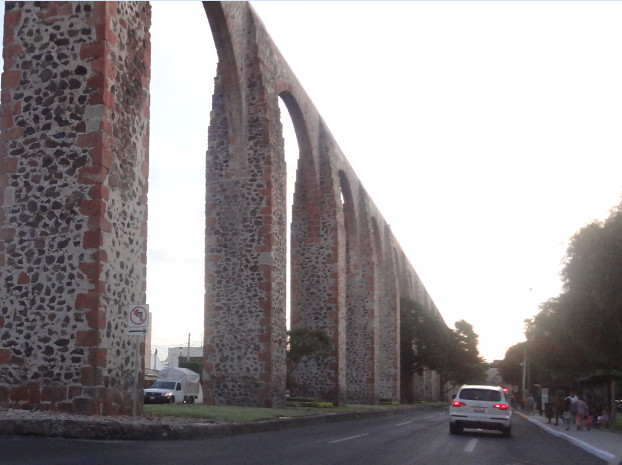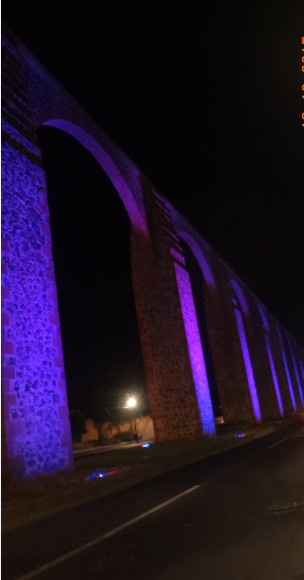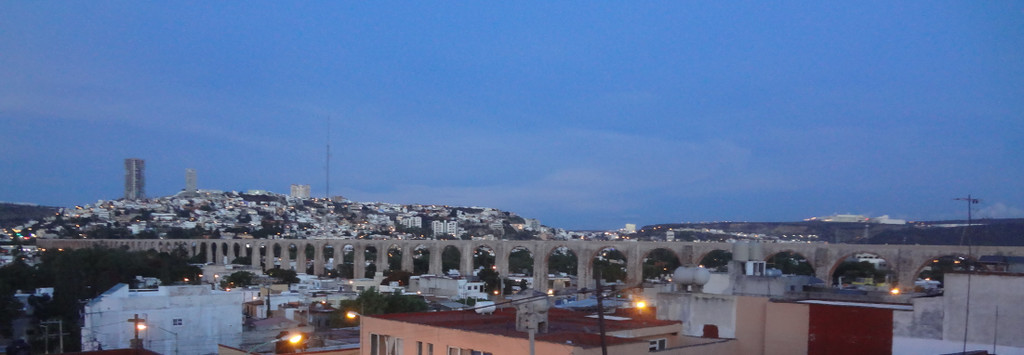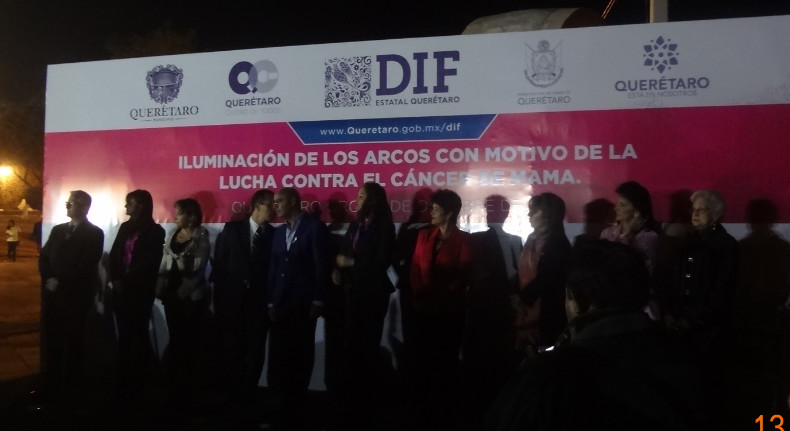You cannot miss out on one of the cities that had most weight in the history of Mexico. Querétaro's historic city centre wasn't declared a UNESCO World Heritage Site in 1996 for nothing; its colonial style has been well-preserved over the years, in addition to keeping and caring for all of the city's legends and traditions.
I am very proud to live in Santiago de Querétaro (Querétaro, for short), as it is one of the safest, cleanest and most well-organised cities in the whole of Mexico. During my exchange here, I realised that this isn't a city that all foreigners have the pleasure of knowing for themselves and I wanted to change that because it is home to an impressive and emblematic construction, one that distinguishes Querétaro from all other cities: this construction is the Querétaro Aqueduct, or "Querétaro Arches", as it's more commonly known.
The water: the biggest problem in Querétaro
Querétaro has always had problems when it comes to water, just as much before, when there wasn't any, as now, with the excessive flooding in the rainy season. For those of you who don't know the city, it can be called arid or desert-like, as the cultivation of crops has always been hindered. At the time, it was impossible for them to prosper due to lack of water, nor could the livestock be kept clean.
We have a river that runs through the city, the Querétaro River, which passes through Avenida Universidad. Despite that river having been there for years and its waters never having been drinkable, it is continually contaminated and, in fact, the people who washed their clothes or bathed in it many years ago suffered from several illnesses; even today, it continues to be a source of infection.

The ambition of a man in love
The story behinds the construction of the arches is a beautiful but, at the same time, sad one (only for the guy who sponsored it, though). I highly recommend taking a trip on Querétaro's touristic buses that you can board in the historic city centre, as they will tell you the following anecdote whilst they pass by this monument that is so valuable to our city.
This anecdote tells the story of a man called Juan Antonio de Urrutia y Arana Perez de Inoriza y Chávarri, a marquis, (if you learn his whole name before the tour is finished, they usually give out prizes! How good is your memory? ) who found himself aware of the issue of the lack of water in the city and had substantial amounts of money. One of the worst things that you can do is fall in love with a nun and think that they are going to feel the same way, but Juan Antonio didn't really bear that in mind and fell hopelessly in love with a Capuchin sister called Sor Marcela, who he met in Querétaro. He asked her several times what he could do to make her love him back, but the nun (who was definitely very clever! ) explained to him that she couldn't because she was devoted to the church and the orders of God. However, she did state that he could make her very happy if he brought water for the people of her city. Although nobody knows what he really said back to her, I am very sure that he told her what anyone would be thinking: nobody builds an aqueduct when there isn't the certainty that it will be absolutely necessary.
Beginning the construction
The construction of the arches didn't take a lot of time. Only twelve years were needed to bring the enormous piece of architecture to life, which, for 1738 (the year that it was completed), isn't bad at all.
The arches in numbers
To give you an idea, the arches measure more than 1 kilometre in length (1. 28 kilometres to be exact), of which there are 74 and change in size and height in accordance with the street that they are situated on. The Calzada de los Arcos has the shape of a "U", so, at the most extreme points, the elevation of the street is raised and the height of the arches gets smaller. However, it's in the city centre where you will find the larger arches, which reach heights of up to 23 metres. The street being shaped in this way facilitated the arrival of water, as it trickled down slowly but without the need of additional architecture because the mere shape contributed to its falling by gravity. Mr Antonio, however, was very intelligent and used his knowledge of hydraulic engineering, so the water ran and travelled down the arches, arriving at a kind of water tank at La Cruz Convent (I also recommend that you visit this) and, from there, it is distributed amongst the different neighbourhoods in the city, mainly in what is now the historic city centre.
In fact, if you visit the historic city centre, you will be able to see some of the very few fountains that remain. These fountains are like curved pools and are built into the city walls. It was in this type of public fountain that the citizens collected their water from, which was brought down by the arches. The Queretano people are so deeply grateful for the work of the marquis that they now have a statue of him, which you will be able to see in the Plaza de Armas located within the historic city centre.
The arches nowadays
The arches are located almost right in the centre of the city and, below them, one of the most important roads in Querétaro passes perpendicular to it - Boulevard Bernardo Quintana. Just to one side of the arches, you will find the Calzada de los Arcos, which is one of the most popular leisure areas in the city, as this is where numerous bars, cafes, restaurants, nightclubs and clothing stores are located.

(The arches from Boulevard Bernardo Quintana)
It's beautiful to see the arches at night, as they are currently used on several occasions of national importance that symbolise different important dates or celebrations. For example, during the national holidays on September 15th, the lights installed on the ground shine green, white and red, representing the colours of the Mexican flag. During the month of October, they usually light up in the colour pink to show the state's solidarity with the victims of breast cancer, and, when the Christmas holidays are celebrated in December, this construction is decorated specially for the occasion and, from time to time, they set off fireworks that create a beautiful panorama shot full of lights.

The most beautiful sunsets are the ones in Querétaro: us citizens are very much used to letting ourselves be spoilt by the sky's gorgeous oranges, pinks, blues and purples. I don't know if you know, but the sky in Querétaro fascinated the Argentinian writer, Jorge Luis Borges, so much that in his book, "El Aleph", he described the sky using the following phrase (that we feel very proud of):
"Vi un poniente en Querétaro que parecía reflejar el color de una rosa en Bengala", which, in English, translates as, "I saw a sunset in Querétaro that seemed to reflect the colour of a rose in Bengal".

I want a photo with the arches!
Unfortunately, the arches are located on one of the busiest roads with the most traffic in the city, so the majority of us are used to travelling along it and visiting it from the comfort of our cars. In fact, even the Turibus (a touristic bus that takes you to all of the main attractions in the city) doesn't make a stop as such at the arches because there isn't a specific access point for pedestrians and for those who want to take a photo.
Don't be disappointed though because the government has built a lookout point so that you can admire the beautiful architecture built in a quarry: on the side that goes towards La Cruz Convent (ask someone which side it's on because, having been a citizen of Querétaro for 10 years, sometimes I get mixed up and I don't want to give you the wrong information), you will be able to get to the lookout point, where you can appreciate both the city of Querétaro and, in almost their entirety, the Querétaro arches.

(View from the lookout point)
Are there other places close-by that I can visit?
The most important sights in the city are concentrated together in the historic city centre, so, with you being at the arches, you will be able to visit many places of cultural interest located close by, like: the Panteón de los Queretanos Ilustres, the Temple of Santa Cruz, and, one of the most important, the Cerro de Campanas ("Hill of the Bells"). The latter attraction owes its reputation to a national and international historically important event - the triple execution of a European emperor, a Mexican president and a Querétaro-born cavalry general.
How much does it cost to visit?
The arches are a representative monument and are situated on a public thoroughfare, so it won't cost you anything to take photos, nor will it cost you money to access the lookout point.
Price of a taxi from the city centre:
They should charge you more or less $50 Mexican pesos, which would end up working out at 2. 15€.
Price of a taxi from the outskirts of the city:
The price can vary anywhere in the region to $70-$100 Mexican pesos, obviously increasing in price in accordance with the distance from the city centre. However, it is important that you know and are aware of these prices because they aren't necessarily fixed, meaning that the taxi drivers can change them if they detect that you are a tourist. Anyway, based on the above prices, the journey would end up costing approximately between 3€ and 4. 30€.
How do you get there?
There is no metro system in Querétaro like there is in other cities, and, sadly, the public bus system is not so efficient... So, I recommend taking a taxi there from wherever you are staying because they don't charge you crazy amounts and it's a very quick way of getting around; you only have to tell them, "take me to the arches", and they will know how to get there.
Recommendations
- Visit the arches both during the day and at night. During daylight hours, you will be able to appreciate them much better and, at night, the colourful lighting will leave you speechless.
- If you want to take the touristic bus that travels around the entire city, you must go to the city centre to catch it, which is about 10 minutes away. Lots of people don't know where to catch it from, but you must first find the tourist information points that are situated in the most important squares in the historic city centre.

 What to see Queretaro,
Queretaro,
Mexico
What to see Queretaro,
Queretaro,
Mexico
 What to see Queretaro,
Queretaro,
Mexico
What to see Queretaro,
Queretaro,
Mexico
